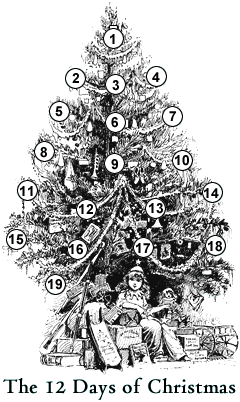Dear Fr. Edward,
Thank you for composing "Some lines four years
old, and it is the Feast of Saint John tomorrow."
Treasures in the Christmas Octave.
The visions test to our contemplation of Apocalypse.
The Father loves the Son and at the Manger mind goes to Joseph, father, love the Son.
Yours, Donald
-
----- Forwarded Message -----
From: edward
...
To: Donald
Nunraw ...
Sent: Wednesday,
26 December 2012, 23:48
Subject: On
John Apocalypse and Gospel
Dear Father Donald,
I was looking out this composition of four years ago. It appears in my
lists under two titles and I cannot remember why. I shall read parts
of it to the Sisters in the morning as a homily. ...
One would expect the apocalypse John to think differently from the Gospel
and epistles John. He was trying to catch a fugitive vision and be accurate.
But with the gospel he was drawing on thirty years' more
contemplations, drawing on personal memories..
O set my task of sorting out the numbered events - trumpets etc.
I leave it in your hands.
[I
wrote it with overriding intention of establishing a pattern for the
Chronology of events, but
although I think I achieved that, the
middle, development section
(as they say in music) is too complex for
them.]
I was very tired on Tuesday,
but I revive!
I hope all goes well, despite
the unwelcome bad weather!
Blessings in Domino - to
think of what we born into ...
fr Edward O.P.
Father Edward Booth O.P.
Austurgata 7,
IS-340 Stykkishólmur,
Iceland.
Saint
John's Apocalypse – a poetic exegesis
When revelation comes
what is revealed is anticipated as different.
So with apocalyptic
and with John.
A world of terror and consolation
inrupted Patmos with its grapes and olives.
Higher still a door opened
more than once
to reveal transcendent worship.
The vision passed between the terrors
and their threat, and the worship of earth
with the plight of the faithful seen in movement
but secure.
The Chief Pastor gave his letters
to the Asian churches
bereft of John as Pastor,
seeking heroic service.
Those animals:
the lion-like, the bull-like,
the human-faced, the eagle-like,
joined in worship with the twenty-four elders,
suffused with praise outpoured.
Not angelic, but seen by Ezekiel
at Babylon:
so many parallels here
with the Word.
Unearthy, but thereby bonding heaven and earth
in full responsive tension.
The scroll-book:
its seals breakable,
itself openable only by the Lamb:
music of harps
and bowls of prayer-incense.
Then angels in thousands,
with all creation worshipping
the Lamb.
He broke the seals one by one,
at each the animals cried 'Come!'
A white horse with rider,
bow-wielding,
crowned for victory after victory.
A red horse, its rider with a sword,
set to end peace on earth
and start mutual slaughter.
A black horse, its rider
holding scales
to measure corn and barley
not oil or wine.
The fourth was deathly pale,
its rider Plague,
and Hades followed.
They all to kill
a quarter of the earth
by sword, famine, plague, wild beasts.
The broken fifth revealed
the martyrs crying for vengeance.
The sixth broken,
came an earthquake:
the sun turned black,
the moon blooded,
the stars fell like figs
dropping in a wind.
An angel poised
to devastate the land and sea
until the elect of Israel are sealed,
with them the persecuted from the nations.
Why charged with this destruction?
To dislodge and reveal
the others' hidden sins and tendencies
to define election and success.
All must out
to make all new.
The seventh broken,
a silence followed.
Seven trumpets for seven angels.
An eight came to the altar:
first offered incense with the prayers of saints.
Then filled the censer with fire
and cast it on the earth.
The seven each trumpeted a rising call
At the first, a fire struck the earth
burning a third, a third of trees
and every blade of grass.
The second:
then as if a flaming
mountain
dropped in the sea;
the sea turned blood,
a third its living content dead,
a third its ships destroyed.
The third:
like a ball of fire
a star fell in the sea:
a wormwood star
making the water wormwood
and undrinkable.
The fourth:
a third of the sun,
the moon, the stars
were blasted:
no light by day or night.
A circling eagle cried:
'Trouble for all peoples
from the three trumpet blows
that remain!'
The fifth:
a star fell opening up the Abyss.
Locusts fell from the smoke
with scorpions stings,
to attack the unsealed
and injure five months long,
making men long for death,
armoured for battle, crowned,
with women's hair.
Their wings
sounded like battle chariots.
The sixth trumpeter was commanded
from the altar to release
four angels chained at the Euphrates, and
with their army of
ten thousand times ten thousand
to destroy
a third the human race;
flame-coloured breast-plates,
the horses lion-headed
exhaling plagues
fire, smoke and sulphur.
Power also in
their snake-like tails.
The human survivors,
unmoved, kept to their idol worship,
nor ceased their murders, sorceries,
theft and fornications.
A further angel,
straddling sea and land,
roared like a lion,
a scroll in hand.
'The waiting time is passed.'
To John:
'Eat this scroll!'
As with Ezekiel:
sweet in the mouth,
but unlike, sour in the stomach.
“Now you can prophesy!”
And, as with Ezekiel,
'Measure the Temple,
the people, but not the outer court.
Two will there prophesy,
but the Abyss will rise and kill them.'
The world was glad – their preaching
pleased them not.
But God enlivened them by his Spirit
(here an Ezekiel parallel with dead bones),
they rose cloud-born to heaven.
Then came an earthquake;
seven thousand dead;
those surviving praised God.
All, the second trouble.
The seventh trumpet blew.
Heavenly voices gave a meaning
to all this stirring, all this killing.
'The Kingdom of the world
has become the Kingdom
of Our Lord and his Christ!'
The elders worshipped:
'Give thanks to He-is-and-He-was
for his power and his reign.
The nations showed their anger;
now God shows his own.
A time for judgement and reward;
destroy those who destroy the earth!'
The Sanctuary appeared again,
inside the acacia Ark
made by Moses to contain the Law re-written
as covenant.
So heaven showed that covenant
ratified as holy, timeless,
the setting for salvation:
not peered at in hope
but realist.
Then lightnings, thunder, earthquake and hail:
a earthly share of a cosmic scourge
dislodged by sanctity.
Then two great signs:
first 'a Woman'.
And the dragon which Daniel saw
twice in derived form in Babylon,
and expounded to Cyrus;
this its reality.
Then Satan, lurking alive:
cause of the world's woes,
now dislodged,
his refuge left behind.
The Woman came first.
Triumphant over sun and moon,
glorified by twelve stars.
Heavenly, so 'her earthly course ended'
yet with the pangs of earthly childbirth.
A Boy was born,
destined to rule all nations;
taken straight to the single Throne of Heaven
to validate his divinity.
Bereft of the woman
escaped into a pagan desert,
home of Artemis-Diana,
looked after by John.
Accessing heaven, the Satan-dragon
continued to fight,
and be cast down to earth.
A heavenly voice cried
'Victory to God and his Christ!',
bought by the Lamb's blood
and the martyrs' witness.'
Heaven will rejoice,
but trouble comes to earth and to sea.
The Satan-serpent pursued the Woman,
vomiting a river of water;
the earth swallowed it up.
Immaculate impugnability and her heavenly state
made her secure on the earth
whilst he menaced her children.
John saw re-rehearsed
the vision of Daniel:
Babylon its setting,
but serving to bolster spirits
against Greek Antiochus.
His Beast is one;
Daniel's were four.
All came from the sea,
emerged out of its secrecy
and now as real.
Not dormant,
for their power underlay
all earthly woes.
Their horns of power,
multiple to menace,
with
eyes all-seeing
like the
eyes of insects.
All-seeing, but no
cause of unity;
still growing,
sprouting,
unlike the single
horn of salvation
claimed by Zachary
for Yahweh.
The ultimate
dislodgement,
discerned by John
as one.
Daniel´s beasts
-
must be eternalised,
real, accessible.
The cadre of the ancient Covenant
is the single cadre from which
salvation comes,
now hyper-semitic.
Daniel intermits
a vision of
the Ancient of Days, with
the 'coming of the Son of Man'
with universal sovereignty.
Then four kings from the earth,
the final first stronger than the Saints,
then overthrown.
Two beasts, smaller in power,
not smaller in contempt:
a he-goat, King of Javan [= Greece],
to subdue a ram
with horns of Medes and Persians.
Gabriel explained this vision to Daniel
as he explained to Mary her vocation.
Then Gabriel explained the span
of seventy weeks for salvation
(fulfilled between Zachary's encounter with him
and Jesus' presentation, Mary's purification,
in the Temple).
He prophesied Antiochus Epiphanus,
his Temple-profanation,
and foresaw his doom.
Michael brought his victories too:
distress unparalleled to come,
but limited in time.
Like those four beasts of Daniel,
John's rose from the sea;
not seen before as such
but underlying all earthly evil.
Seven-headed (one once wounded and then healed)
ten horns brazen with blasphemous titles.
Leopard-like, paws bear-like,
its mouth lion-like.
The Satan-dragon gave him
its throne, its power and authority.
The whole world marvelled,
followed it boasting and blaspheming
against God,
allowed to wreak its power
against God and over the Saints.
The world gave worship;
the Saints had constancy and faith.
A minor beast came from the earth,
two lamb-like horns,
dragon-like in noise;
serving the first
and prophesying falsely,
making its statue
inbrearthing it with life;
slaying those who would not worship,
branding all with '666',
excluding the rest from trade.
Then on Mount Zion, the Lamb
with twelve times twelve thousand
signed with the Father's name, all harpists
like the ocean's sound
or roar of thunder.
Virginal, first fruits of God,
always Lamb-followers.
Another angel
announcing the gospel of eternity:
'Fear God, praise him:
he comes in judgement.'
(So Michael to Daniel:
'Through distress
the dead shall rise:
some to life for ever,
some to shame and disgrace.
The learned, those who taught virtue,
bright as eternal stars.')
A second cries '(The) Babylon (of Rome)
has fallen,
which gave the world God's anger-wine.'
A third: 'The worshipper of beast and statue,
those branded '666'.
will drink God's fury-wine
in's anger-cup.
Their torture-smoke
will rise for ever.'
But, 'Happy those who die in the Lord.'
One 'like a son of man' cried
'with your sharp sickle
reap the ripe harvest of (the pagan) earth.'
An angel joined the reaper
sickling the vines of earth,
'cut its branches, all its grapes are ripe.'
The grapes were piled
in the winepress of God's anger,
trodden until blood poured out,
horse-bridle high,
for sixteen thousand furlongs.
Some angels brought the last plagues of all,
exhausting God's anger.
Meanwhile, standing beside 'a glass sea
suffused with fire',
the victors over the beast, his statue
and his number-name:
all with harps, singing
the song of Moses and the Lamb,
'How good and wonderful are your works ...
You alone are Holy,
and all the peoples will worship you.'
Now, enshrined in heaven,
the Tent of the Testament was opened.
The four animals from the beginning,
true mediators between heaven and earth,
gave to each of seven angels
a bowl of God's anger
to pour down,
to accomplish the purging of men and earth.
The first on earth, on beast-branded men;
the second on sea,
making it blood, killing all within;
a third turned rivers and springs to blood;
a fourth on the sun to scorch,
though men did not repent for God but cursed;
a fifth on the beast making his whole empire dark,
and here again men cursed;
a sixth dried the Euphrates for Eastern kings to pass.
Demon spirits came from the mouths
of Satan-dragon, beast and false prophet,
performing miracles,
calling the world's kings to war on God
at Armageddon,
but he will come like a thief.
A seventh poured his bowl on the air.
A voice from heaven: 'The end has come'.
Lightnings, thunder, violentest ever earthquakes.
Cities drank this anger and exploded.
All islands, mountains vanished.
The worst was hailstones, each a talent-weight,
falling from the sky:
men cursed it.
For (Rome-)Babylon
a special end:
a prostitute to all earth's kings
An angel took John to a desert
to see its end to come.
The mother of all prostitutes and their filth,
purple- and scarlet-clad,
her gold, jewels, pearls a-glitter,
riding a scarlet beast:
seven-headed,
ten-horned with blasphemous titles.
Drunk with martyrs' blood,
holding her luring, filth-filled cup.
'That beast', the angel said,
'will rise from the Abyss:
now is not, yet still to come.'
Seven heads are seven hills, seven emperors,
ten horns ten kings.
They plot a war against the Lamb,
to be defeated by his chosen faithful.
Her 'abundant waters': all peoples, nations, languages.
But horns and beasts will turn against her,
leave her naked,
eat her flesh,
burn her remains.
God contrived the whole conflict
for their destruction.
Cries come from heaven,
'Babylon is fallen!'
Another: 'Leave her to her plagues':
every orgy will be matched
by a torture or a grief.
Yet, from a safe distance
she is mourned by some;
for her merchants
no more fortune-profit.
Another angel:
'she will end
like a great millstone
cast into the sea.
In her the blood of saints and prophets,
all blood ever shed.'
The process continues:
a chain of anticipations and fulfilments.
Animals and elders sing always 'Alleluia';
they know no other song.
The Bride awaits the Lamb,
but yet it waits as prophesy.
A white horse appears
ridden by 'Faithful and True'.
An angel calls the birds to eat the fallen flesh.
Beast and all kings fight the rider
and his army;
beast and false prophet
are made prisoners:
thrown in a fiery lake of burning sulphur.
Their host is slain by the rider's sword
come from his mouth;
the birds are gorged with flesh.
An angel chains the Satan-dragon
in the abyss's depths.
There for a thousand years;
then brief released.
Martyrs resurrected take their thrones
to judge the world:
the first resurrection.
Then Satan-dragon comes forth
with Ezekiel's Gog and Magog,
prepares for war
against the saints,
so loved by God.
All consumed by fire from heaven!
Satan's thrown with beast and false prophet
into the eternal torture of the
lake of fire and sulphur.
The process: long,
oscillating by need,
but sure.
God, enthroned in power;
earth and sky vanish:
no trace left.
The dead stand before him,
are judged by the all-certain
record-book,
The sea gives up its dead.
Death and Hades are emptied,
thrown into the lake
with those rejected
by the Book of Life.
New Heaven and New Earth,
the old has disappeared;
there's no more sea.
A new Jerusalem descends from heaven;
God living among men;
married by the Lamb:
a jewel of diamond crystal-clear.
High walls; twelve gates,
three on each side,
at each an angel.
Named from the tribes,
but hyper-semitic:
the old is cadre for the perfect new.
Twelve foundation stones
named from the Lamb's apostles.
Perfectly ordered,
built from precious stones.
No Temple!
The Lord and the Lamb themselves
the Temple.
No light,
but the radiant glory of God.
The nations will come there
As with Ezekiel,
but from throne not Temple,
water flows crystal-clear
down the middle of the city street,
promoting trees cropping
twelve times a year,
their leaves to cure the pagans.
The servants of God will worship there,
face to face with him.
John wrote what he saw,
not in ecstasy
and unlike Daniel bearing all:
not as a secret,
but to be told.
28-29
December 2008
Stykkishólmur
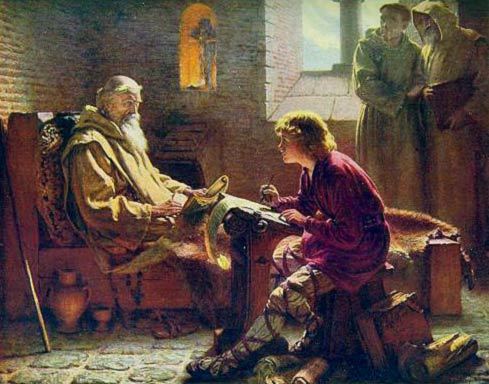


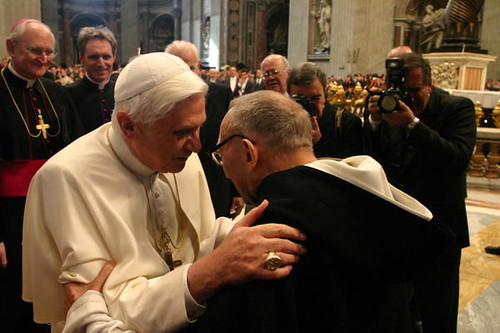

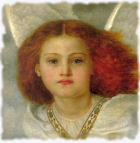


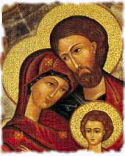 Today is the feast day of the Holy Family, but also every family's feast day, since the Holy Family is the patron and model of all Christian families. Today should be a huge family feast, since it is devoted entirely to the Holy Family as a model for the Christian family life. As Rev. Edward Sutfin states:
Today is the feast day of the Holy Family, but also every family's feast day, since the Holy Family is the patron and model of all Christian families. Today should be a huge family feast, since it is devoted entirely to the Holy Family as a model for the Christian family life. As Rev. Edward Sutfin states: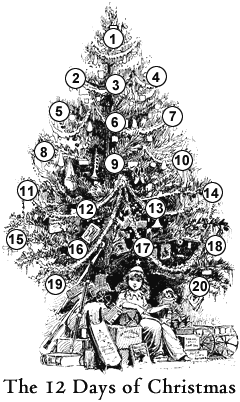
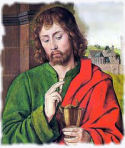 St. John was born in Bethsaida, and like his brother James, was a fisherman. He was called while mending his nets to follow Jesus. He became the beloved disciple of Jesus. He wrote the fourth Gospel, three Epistles and the Apocalypse. His passages on the pre-existence of the Word, who by His Incarnation became the light of the world and life of our souls, are among the finest of the New Testament.
St. John was born in Bethsaida, and like his brother James, was a fisherman. He was called while mending his nets to follow Jesus. He became the beloved disciple of Jesus. He wrote the fourth Gospel, three Epistles and the Apocalypse. His passages on the pre-existence of the Word, who by His Incarnation became the light of the world and life of our souls, are among the finest of the New Testament.